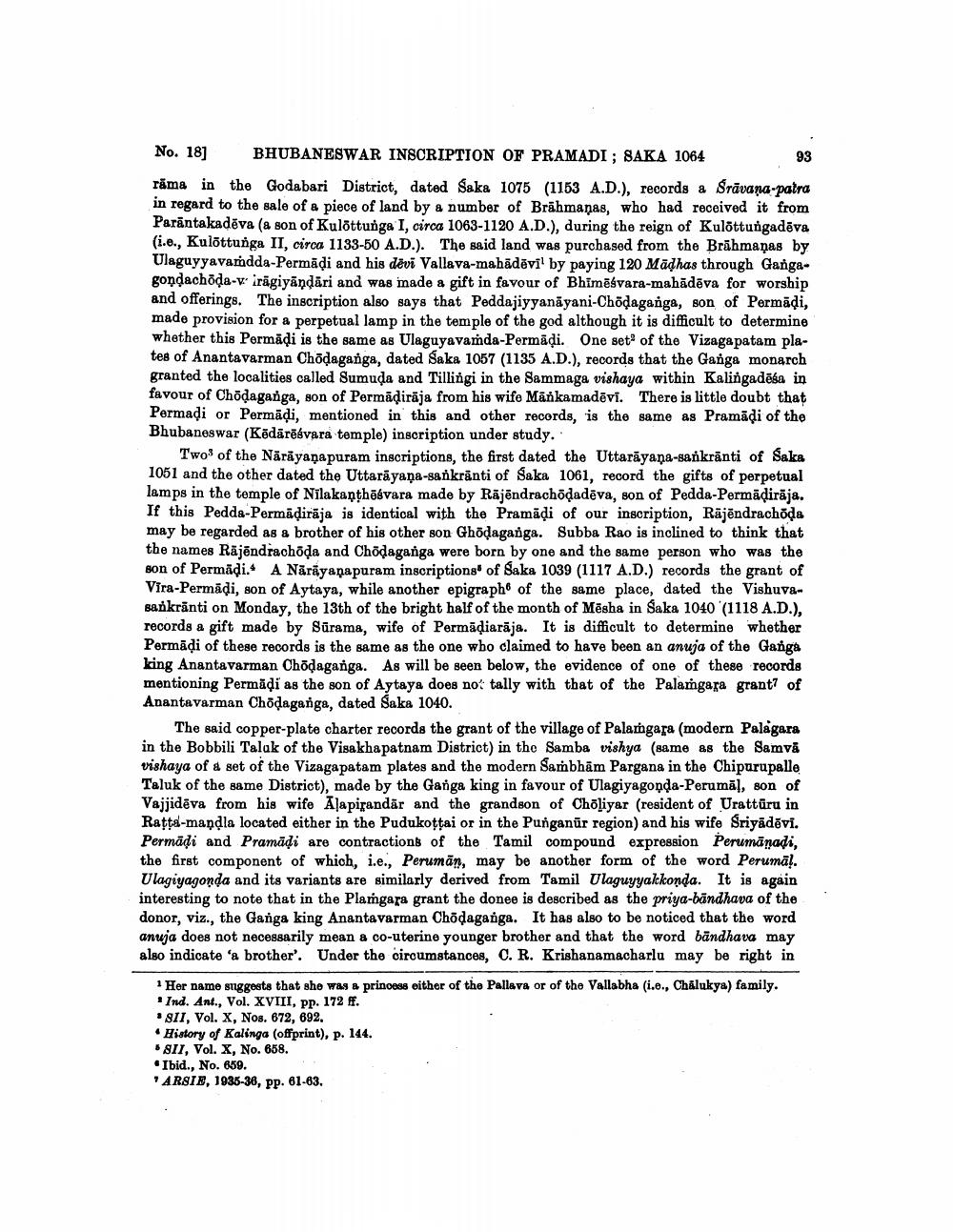________________
No. 18] BHUBANESWAR INSCRIPTION OF PRAMADI; SAKA 1064
93 rāma in the Godabari District, dated Saka 1075 (1153 A.D.), records a Srāvana-patra in regard to the sale of a piece of land by a number of Brāhmaṇas, who had received it from Parāntakadēva (a son of Kulõttunga I, circa 1063-1120 A.D.), during the reign of Kulottungadēva (i.e., Kulottunga II, circa 1133-50 A.D.). The said land was purchased from the Brāhmaṇas by Ulaguyyavamdda-Permādi and his devi Vallava-mahādēvil by paying 120 Mādhas through Gangagondachoda-virägiyāņdāri and was made a gift in favour of Bhimēsvara-mahādēva for worship and offerings. The inscription also says that Peddajiyyaniyani-Chödaganga, son of Permādi, made provision for a perpetual lamp in the temple of the god although it is difficult to determine whether this Permādi is the same as Ulaguyavamda-Permādi. One set of the Vizagapatam plates of Anantavarman Chōdaganga, dated Saka 1057 (1135 A.D.), records that the Ganga monarch granted the localities called Sumuda and Tillingi in the Sammaga vishaya within Kalingadēša in favour of Chödaganga, son of Permadiräja from his wife Mankamadēvi. There is little doubt that Permadi or Permadi, mentioned in this and other records, is the same as Pramādi of the Bhubaneswar (Ködärēsvara temple) inscription under study.'
Two of the Nārāyanapuram inscriptions, the first dated the Uttarāyana-sankranti of Saka 1051 and the other dated the Uttarāyaṇa-sankranti of Saka 1061, record the gifts of perpetual lamps in the temple of Nilakanthēsvara made by Rājēndrachödadēva, son of Pedda-Permadirāja. If this Pedda-Permādirāja is identical with the Pramãdi of our inscription, Rājēndrachöda may be regarded as a brother of his other son Ghõdaganga. Subba Rao is inclined to think that the names Rājēndrachöda and Chödaganga were born by one and the same person who was the son of Permādi. A Nārāyanapuram inscriptions of Saka 1039 (1117 A.D.) records the grant of Vira-Permādi, son of Aytaya, while another epigraph of the same place, dated the Vishuvasankranti on Monday, the 13th of the bright half of the month of Mēsha in Saka 1040 (1118 A.D.), records a gift made by Surama, wife of Permāņiarāja. It is difficult to determine whether Permāļi of these records is the same as the one who claimed to have been an anuja of the Ganga king Anantavarman Chōdaganga. As will be seen below, the evidence of one of these records mentioning Permadi as the son of Aytaya does not tally with that of the Palamgara grant7 of Anantavarman Chödaganga, dated Saka 1040.
The said copper-plate charter records the grant of the village of Palamgara (modern Palagara in the Bobbili Talak of the Visakhapatnam District) in the Samba vishya (same as the Samvå vishaya of a set of the Vizagapatam plates and the modern Sambhām Pargana in the Chipurupalle Taluk of the same District), made by the Ganga king in favour of Ulagiyagonda-Perumāļ, son of Vajjidēva from his wife Alapisandār and the grandson of Choliyar (resident of Urattūru in Rattal-mandla located either in the Pudukottai or in the Punganūr region) and his wife Sriyādēvi. Permādi and Pramādi are contractions of the Tamil compound expression Perumānadi, the first component of which, i.e., Perumān, may be another form of the word Perumal. Ulagiyagonda and its variants are similarly derived from Tamil Ulaguyyalckonda. It is again interesting to note that in the Plamgara grant the donee is described as the priya-bändhava of the donor, viz., the Ganga king Anantavarman Chodaganga. It has also to be noticed that the word anuja does not necessarily mean a co-uterine younger brother and that the word bändhava may also indicate 'a brother'. Under the circumstances, C. R. Krishanamacharlu may be right in
1 Her name suggests that she was a princess either of the Pallava or of the Vallabha (i.e., Chalukya) family, . Ind. Ant., Vol. XVIII, pp. 172 ff. *SI1, Vol. X, Nos. 672, 692, • History of Kalinga (offprint), p. 144. .SI1, Vol. X, No. 658. Ibid., No. 659. ARSIE, 1936-38, pp. 61-63.




